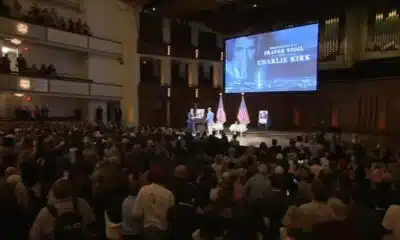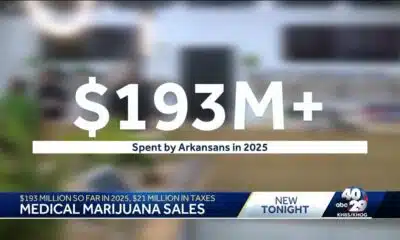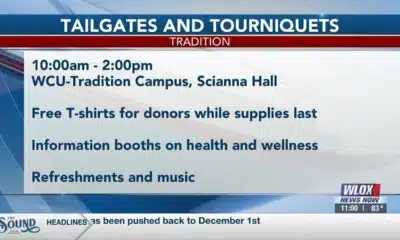News from the South - West Virginia News Feed
Tech-related tariffs remain uncertain, but prepare for cost hikes, experts say
by Paige Gross, West Virginia Watch
April 25, 2025
The price of technology goods and services in the U.S. will likely rise in the next few months, experts say, as the White House continues to shift its strategy on tariffs for imported electronic hardware.
After initial reports that Chinese goods would receive as high as a 145% tariff, President Donald Trump said on April 13 that electronics like smartphones, computers and semiconductors — chips that process, power and transmit information — would be exempt. But Trump said later that day that imported semiconductors, and the electronics they’re embedded in, will likely be facing their own tariff structure in the coming weeks.
In tandem with Trump’s announcement, the U.S. Department of Commerce announced an official investigation into semiconductor imports, aiming to study the national security implications of importing manufacturing equipment and derivative products. The move is likely two-fold, tech experts say — Trump’s aim with foreign tariffs is to pressure American manufacturers to make more goods in U.S. facilities.
But his administration is also likely looking for cybersecurity risks that could be introduced through foreign manufacturing, like in compromised operating systems, embedded malicious code, or flawed designs, said Derek Lemke, senior vice president of product level intelligence at risk management firm Exiger.
“They power everything from advanced weapons systems and critical infrastructure to smartphones and laptops,” Lemke said. “Many of these components are manufactured abroad, often in regions with rising geopolitical tensions or limited transparency into supply chain practices.”
The U.S. is currently upping its manufacturing of semiconductors. It produced about 10% of the world’s semiconductors in 2022, and is projected to reach 14% by 2032 with the additional funding and infrastructure provided by the CHIPS and Science Act, passed during the Biden administration. But while many advanced chips are designed by American companies like Nvidia, Apple, Qualcomm and AMD, they are manufactured in Taiwan, which is currently negotiating tariff deals with the U.S.
Many electronics involve manufacturing processes from all over the world, making the tariff structure involved a complicated one. And while it’s a good idea for Americans to manufacture more of their semiconductors to diversify the global supply chain of chips, the country is nowhere near prepared to make as many as we need, said Nikolas Guggenberger, an assistant professor of law with a focus on antitrust, law and technology, privacy, and regulation at The University of Houston Law Center.
Guggenberger called semiconductor manufacturing “among the most complex industrial processes on Earth,” which would require years of planning, training and billions in investment for the U.S. to become a leader.
While the U.S. awaits more clarity over tariffs on electronic goods and the findings of the semiconductor probe, Guggenberger and Lemke say that American consumers should prepare themselves for higher prices on smartphones, laptops and other personal devices. Because semiconductors are used in so many everyday products, those price hikes could seep into wider spending, Guggenberger said.
“From a computer to everyday devices, like a garage opener, or a toaster,” he said. “It’s everything, it’s absolutely everything.”
Guggenberger said there’s a possibility that very high tariffs could also lead to a pause or slowdown in manufacturing in general, meaning consumers may see emptier shelves or a backlog on products in a few months.
Those on the software side of the tech industry will feel the effects, too, Lemke said. Software companies, AI developers and cybersecurity experts all rely on computing power from chip hardware, and disruption in the supply chain could slow innovation in these businesses, he said.
Even just the discussion of tariffs is having a ripple effect through the tech sector, Lemke said. Companies are having to evaluate their supply chains, their sourcing and maybe stockpile some components to their products.
“The uncertainty alone is enough to influence pricing, procurement strategies and investment decisions across the tech ecosystem,” Lemke said.
West Virginia Watch is part of States Newsroom, a nonprofit news network supported by grants and a coalition of donors as a 501c(3) public charity. West Virginia Watch maintains editorial independence. Contact Editor Leann Ray for questions: info@westvirginiawatch.com.
The post Tech-related tariffs remain uncertain, but prepare for cost hikes, experts say appeared first on westvirginiawatch.com
Note: The following A.I. based commentary is not part of the original article, reproduced above, but is offered in the hopes that it will promote greater media literacy and critical thinking, by making any potential bias more visible to the reader –Staff Editor.
Political Bias Rating: Center-Right
This article primarily focuses on the implications of the Trump administration’s tariff policies and the investigation into semiconductor imports. The content is not overtly political but highlights actions taken by the Trump administration, such as the investigation into semiconductor imports and the potential national security risks associated with foreign manufacturing. The article maintains a neutral tone but is likely to resonate more with a Center-Right audience due to its focus on economic nationalism, national security concerns, and a favorable portrayal of U.S. manufacturing efforts (particularly those tied to the CHIPS Act, passed under the Biden administration). There is some subtle tension in discussing the complexity and challenges of U.S. manufacturing capabilities, but the article doesn’t express a clear ideological stance, focusing instead on factual reporting. The use of experts to comment on the likely impacts of tariffs and supply chain disruptions keeps the tone relatively balanced, though the framing of tariffs as a pressure tactic on American manufacturers may lean towards a more conservative viewpoint on economic policy.
News from the South - West Virginia News Feed
Ohio neighborhood fears landslide as retaining wall slips
SUMMARY: In Portsmouth, Ohio, a retaining wall has been slipping for about five years, causing fear among residents like the Yuri family who moved in just before the slip began. Despite support beams installed two years ago, cracks in the wall allow water to gush through, flooding parts of the road and raising concerns about a potential catastrophic landslide. Local councilman Shawn Dun highlights questions about the wall’s stability and estimates repair costs near $2 million, with the city seeking grants to fund the work. Residents anxiously await repairs, hoping the problem will be resolved soon to prevent disaster.
A cloud of concern hovers over one Portsmouth neighborhood. Those living along Richardson Road wonder how much longer a retaining wall will hold and keep a hillside from sliding that would damage their property. The support wall began slipping 5 years ago. A couple years later, support beams were put in place for a problem that those living along the street say is a ticking time bomb.
FULL STORY: https://wchstv.com/news/local/a-ticking-time-bomb-has-a-portsmouth-neighborhood-living-in-fear
_________________________________________
For the latest local and national news, visit our website: https://wchstv.com/
Sign up for our newsletter: https://wchstv.com/sign-up
Follow WCHS-TV on social media:
Facebook: https://www.facebook.com/eyewitnessnewscharleston/
Twitter: https://twitter.com/wchs8fox11
Instagram: https://www.instagram.com/wchs8fox11/
News from the South - West Virginia News Feed
Christian's Latest Forecast: More Dry Days; Rain Potential Late Next Week
SUMMARY: Storm Watch meteorologist Christian Boler reports mild, mostly dry weather continuing through the weekend with temperatures around 80°F and partly cloudy skies. A high-pressure system will maintain these warm, dry conditions into early next week. Some unorganized tropical rainstorms may bring isolated showers from Tuesday night into Wednesday morning, followed by a dry midweek. Saturday promises significant rainfall, helping to relieve recent dry and minor drought conditions affecting vegetation. Temperatures have shifted from below to above average this week but will dip below average later in the month. Overall, expect more dry days with rain potential late next week, improving moisture levels regionally.
FOLLOW US ON FACEBOOK AND TWITTER: https://facebook.com/WOAYNewsWatch https://twitter.com/WOAYNewsWatch.
News from the South - West Virginia News Feed
Road-widening project gets completion date, property issues remain unclear
SUMMARY: The Cross Lanes road-widening project, expanding Route 622 from Golf Mountain Road to Route 62 near Andrew Jackson Middle School, has resumed after a ten-month pause. Originally set for completion in June 2025, the new completion date is February 2027 due to delays caused by utility pole relocations. Construction is causing traffic congestion, especially around the Kroger turning light, which is being studied for timing adjustments. Despite frustrations, officials emphasize the long-term benefits. Property issues, including damage claims and easements, remain unresolved. Kanawha County lawmakers continue to provide updates as the project progresses.
Source
-
News from the South - Arkansas News Feed7 days ago
Group in lawsuit say Franklin county prison land was bought before it was inspected
-
News from the South - Kentucky News Feed6 days ago
Lexington man accused of carjacking, firing gun during police chase faces federal firearm charge
-
The Center Square6 days ago
California mother says daughter killed herself after being transitioned by school | California
-
News from the South - Arkansas News Feed6 days ago
Arkansas medical marijuana sales on pace for record year
-
Local News Video6 days ago
William Carey University holds 'tailgates and tourniquets' blood drive
-
News from the South - Alabama News Feed6 days ago
Zaxby's Player of the Week: Dylan Jackson, Vigor WR
-
News from the South - Missouri News Feed6 days ago
Local, statewide officials react to Charlie Kirk death after shooting in Utah
-
Local News6 days ago
US stocks inch to more records as inflation slows and Oracle soars















































